Last Updated on July 10, 2022 by Soumya
One of the best-preserved ruins from the Roman Empire is in Portugal. Yes, the Roman ruins of Conímbriga which can be easily done as a day trip from the university town of Coimbra. There are tonnes of interesting things to do in Coimbra but visitors often miss out on rather unknown historical gem that lies just a few hours away from the city. Conímbriga’s Roman Ruins!
In this post, we will take to this offbeat destination which is also a Portuguese National Monument. According to us, the Roman City of Conímbriga is a must-have on every Portugal itinerary, especially those of history and art lovers.
Busy now? Pin our post on Conímbriga ruins and read it later.
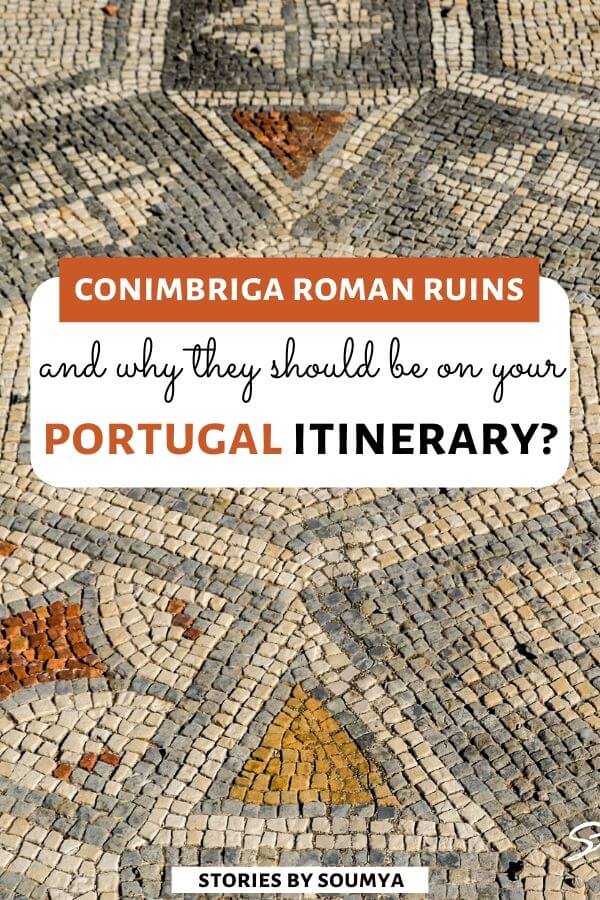
Please note: This post may contain affiliate links which means I may earn a commission if you make a purchase by clicking a link on this post. This will be at no additional cost to you. Affiliate links help me keep this website up and running. Thanks for your support!
A brief history of the Roman ruins of Conímbriga
Conímbriga’s ruins are one of the most impressive Roman sites anywhere in the world. And they are Portugal’s largest and most well-preserved. If this does not excite you enough, then keep reading. Conímbriga has something special.
According to documents from UNESDOC Digital Library, Conímbriga was inhabited by the Celtics as early as the 7th century BC. Romans started arriving here between the 1st and 2nd century AD. Conímbriga had a population of more than 10,000 in its peak.
Conímbriga was invaded by German Suevi tribes in the 5th century AD. The inhabitants tried to quickly construct a wall to repel the attack. This was called the Late-Imperial Wall that almost divided the city into two. But in vain. The Romans fell and the inhabitants fled to nearby Coimbra. Conímbriga was deserted. You can still see stretches of this wall running through the middle of the ruined site cutting through some of the beautiful houses such as the House of the Swastika and the House of Skeletons.
Conímbriga was first excavated only in the late 19th century. Only about 20% of the entire city is believed to have been excavated. What’s special about Conímbriga is its exquisite and colorful collection of mosaic floors. These floors in several houses at the site are still intact or correctly restored. The ones at the House of Fountains are especially remarkable. Come, let’s check out some of them.
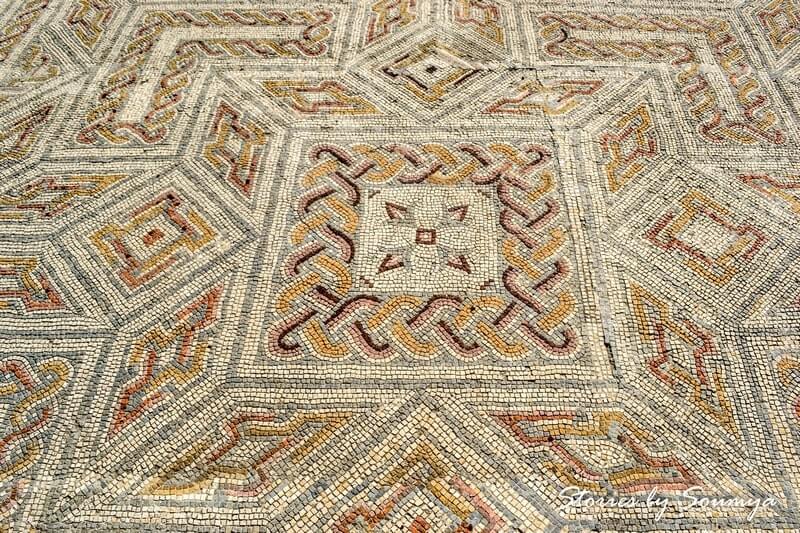
What can you see at the site?
I can divide the historic site into two parts – The Ruins & The Museum called the Museu Monográfico de Conímbriga. We first started with the ruins and ended our tour at the museum.
The Roman ruins of Conímbriga
Begin your tour by taking a left at the entrance. There are no clear signs on which direction to go. But we saw people walking to the left and so we did too. I later realized that on the right, under a carefully-constructed canopy, was the House of Fountains – the highlight of Conímbriga. And I was happy to savor it at the end.
We did a self-guided tour of the Conímbriga ruins. I haven’t come across a good guided tour so far. So, in case you know of one, drop me a line below. Even though signage is bad at the site, there are adequate descriptions at each of the attractions. Reading through them is the best way to appreciate Conímbriga. Here are some of the things we saw as we explored.
The Two Mosaics
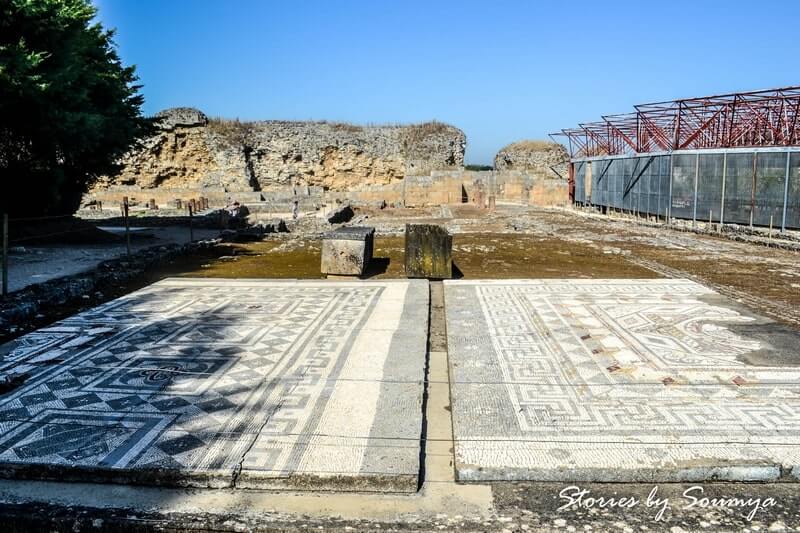
One of the first displays is that of two different mosaics laid out side by side. These, along with two others (now in the museum), were discovered in 1899. They are nearly 2000 years old. The left one is believed to have decorated the floor of the dining room of the House of Cantaber, one of the most remarkable dwellings of the Western Roman world.
Building of Shops
You will next come across a cluster of shops and warehouses from the Roman era. These were mostly destroyed during the construction of the Late-Imperial Wall. However, you can still see the remains of an underground portico, called the Crypto-Portico, that connected the basement shops.
House of the Swastika


Next is the famous House of Swastika – so-called because of the Swastika designs on its mosaics. Apparently, the Romans considered Swastika to be a sign of good luck, a representation of the sun. This house also fell prey to the Late-Imperial Wall. The swastikas on the floor may be hard to decipher especially in all the light and heat. But look carefully and you will find one too many.
House of the Skeletons
After checking out the House of the Swastika, we came across another wealthy, private residence called the House of the Skeletons. It is named so because, after the Suevi invasion, this spot was occupied by a medieval cemetery. Today, you can see the central axial pattern on which the house was constructed and some beautiful mosaics adorning the floor.
Parts of the House of Skeletons were rented out to shops and other commercial establishments for conducting business near Conímbriga’s public baths.
Public Baths of Conímbriga
You can see rudimentary remains of a thermal bath that had different sections for men and women. The write-up at the site talked about decorative motifs in the bath but I could not locate any. It is interesting to note that this planned town system came into existence at the end of the 1st century i.e. 2000 years ago! There is an entire section of the city’s southern baths too beyond which lie the Forum and indigenous houses from a pre-Roman era.
The Forum
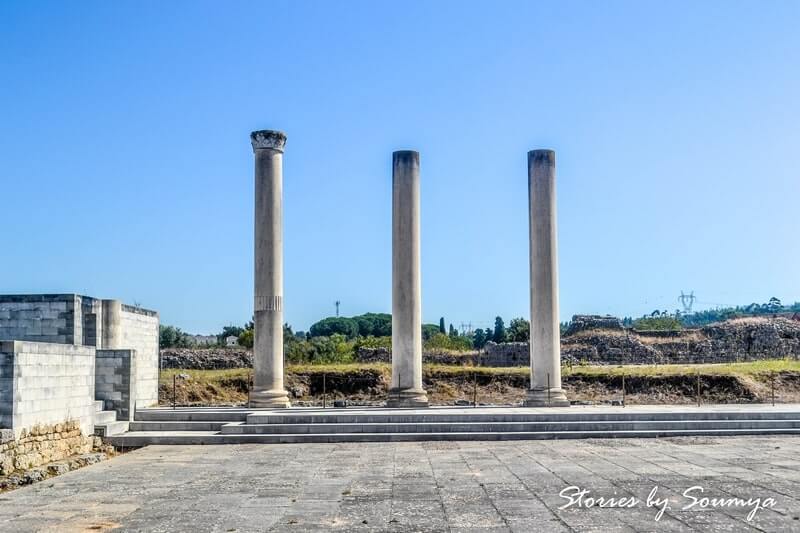
Also known as the Great Flavian Forum of Conímbriga, this was the most important spot in the entire city. The main building of the Forum was a temple (more than 30 feet long) that no longer exists. Restoration is on and you can see three tall pillars beginning to give you a picture of it.
The temple was surrounded by an open area and a covered portico beneath which was another crypto-portico. So many cryptos in there! I was thrilled. Right in front of the temple was a huge esplanade probably overlooking the valley. This area was surrounded by shops of different kinds. Imagine a regular day here. An esplanade filled with people. Families buying their daily needs. Pontiffs moving in and out of the temple. I could almost feel the ancient Romans near me!
There was another tiny thing that I loved here. The wedge-shaped bricks! This is the only place ever I have seen them. They were cleverly designed to create rounded pillars. The ingenuity of the ancient Romans is definitely praiseworthy.
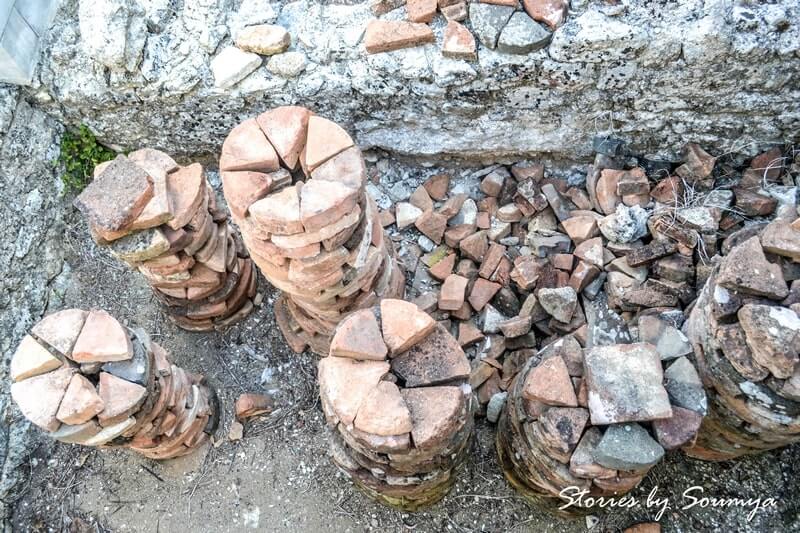
Indigenous houses
Under the temple esplanade, lie several indigenous houses from the Pre-Roman urban era. If you look carefully, you can see two houses with a central yard and two parallel streets. They got buried under the Roman Forum. Who knows what remains buried under the rest of the site!
An Aqueduct & An Amphitheater
You can spot an aqueduct towards the end of the trail right before the House of Fountains. There is also an amphitheater close by with a wooden stage (recently made) and some benches. It is hard to tell how the real amphitheater looked. It was, supposedly, huge and could accommodate more than 4,000 spectators at the same. That is like 40% of the population.
House of Cantaber
And the end of the Conímbriga trail, we came to two important houses. The first one was the House of Cantaber. We spoke a little about this house while exploring the first two mosaics on display.
Cantaber was an important aristocrat of the city. So, his home was the largest. There were 40 compartments here divided into 5 different sections. You can get a feel of the place by looking at what has been restored. But the former glory is all lost. The mosaics in this area were covered with dust. Hopefully, we will get to see some of that glory once the complete restoration is done.
House of the Fountains
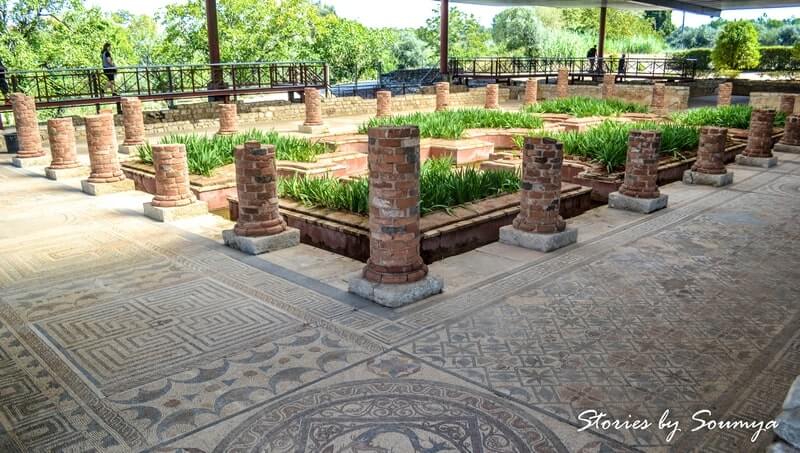
The House of the Fountains is definitely the highlight on your tour of the Conímbriga Roman ruins. It has one of the most well-restored examples of colorful mosaics, murals, and water fountains. The fountains here work if you insert a penny into a box. Quite an exciting adventure for kids in Portugal.
Also known as Casa dos Repuxos, the House of the Fountains also has a protective structure over it. This means there is shade here unlike the other parts of the Conímbriga ruins. And you can explore without being bothered by the heat.
Museu Monográfico de Conímbriga
After you have finished exploring the Roman ruins of Conímbriga, head to the carefully organized museum. There are 4 different galleries here – daily life, religion, and urban architecture separated by homes and office buildings. You can see mosaic panels, Roman coins, Conímbriga pottery, busts, and statues on display here.
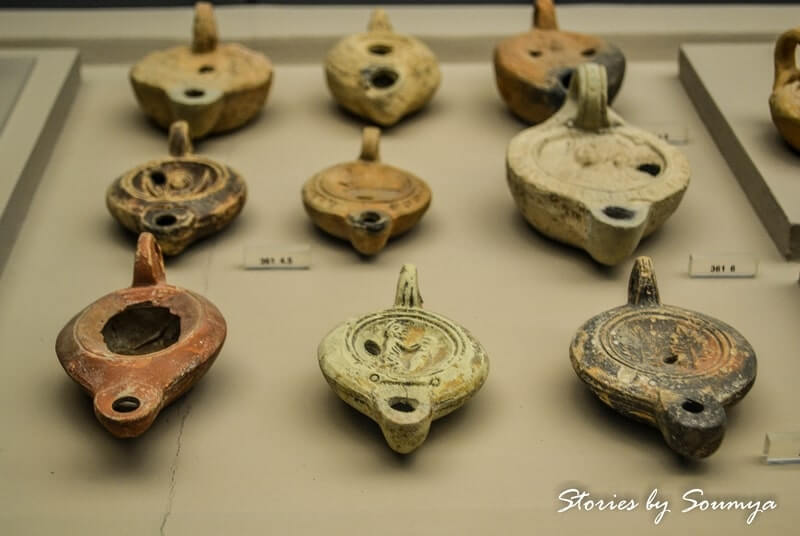
Tickets to Conímbriga Roman Ruins?
Admission to the ruins and the museum is priced at 4.50€ (latest according to the official website of Conímbriga ruins). We paid the same in September 2019. Entry is free for kids.
You can purchase tickets directly at the ticket office on site. The ticket office is open between 10 am – 6 pm every day.
What are the opening hours?
Conímbriga Roman ruins are open throughout the year, Monday to Sunday, except for 4 holidays on January 1st, Easter Sunday, May 1st and December 25th. The museum is apparently closed on Mondays (you would need to verify this with the office). Both the museum and ruins are open from 10 am in the morning till 7 pm in the evening.
How to get to Conímbriga from Coimbra?
You can get to Conímbriga from Coimbra by car or public transport. Since Conímbriga is only 17 km (11 miles) away from Coimbra, the drive takes less than 20 minutes. You can park your car right at the entrance to the ruins.
You can also take comfortable “Transdev (the brand)” buses that run from the bus stop on the banks of the Mondego River in front of the Coimbra railway station. Look out for buses labeled Conímbriga or Condeixa-a-Nova. Confirm with the driver once you get on the bus. One-way rides cost 2.60€ for adults and 1.30€ for kids (as of September 2019). You can get your tickets from the driver.
However, these buses are not very frequent. So, you will have to plan your day accordingly. There are a couple of buses from Coimbra to Conímbriga – at 9:30 am and at 12:30 pm. We took the 9:30 am bus which actually came around 9:45 am! So, be prepared to wait. Buses from the Conímbriga ruins depart at 1:55 pm and 6:25 pm. Again, these are ballpark figures. Getting to the stop a few minutes early and being ready to wait is a good way of not missing the bus!
Where to eat in Conímbriga?
If you are only visiting the ruins, then it is a good idea to grab some snacks at the cafeteria near the museum. We finished our tour of the ruins and went on to have some really fresh salad at the cafe. They also serve warm and crispy pastels!
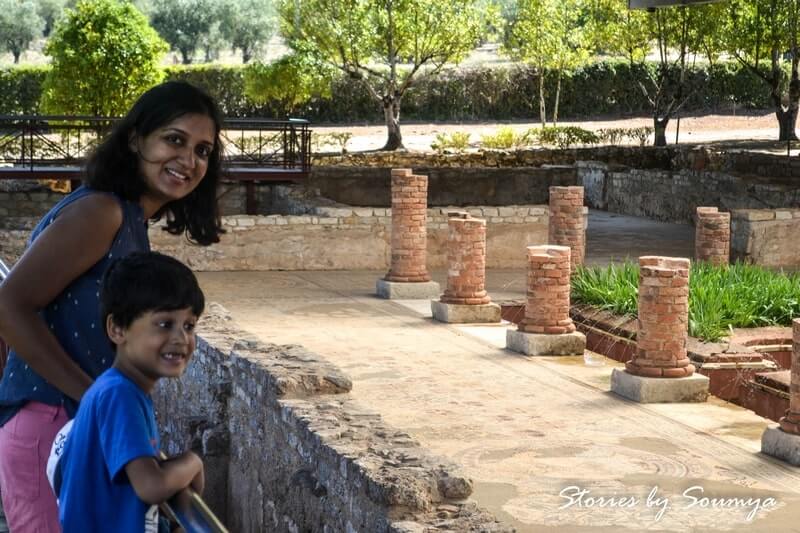
Where to stay?
Coimbra is the ideal place to stay if you are planning to visit the Roman ruins of Conímbriga. There are lots of things to do in Coimbra including visiting the UNESCO-listed Coimbra University. You can check out hotels in Coimbra here.
We stayed at a comfortable pension in Coimbra called Pensão Flôr de Coimbra. It is located in the city center and is only 5 mins away from the Coimbra railway station. That means it is pretty close to the bus stop where you will board the bus to Conímbriga. Plus, the pension is managed by a friendly owner who is always happy to chat with you and take you through the hotel’s age-old history. We loved our stay here. Maybe you will too!
Book your stay at Pensão Flôr de Coimbra here.
We hope you found our guide to the Conímbriga ruins helpful. Let us know if you need any other information and we will try and answer your queries. Also, if you need any help planning your Portugal itinerary, then we have lots about the country.
More Portugal Resources
- What to do with a day in Coimbra?
- Ultimate itinerary for 10 days in Portugal
- 15+ Incredible things to do in Portugal with kids
- The best things to do in Porto
- 9 Off the beaten path experiences in Lisbon
Loved your guide on Conímbriga Roman Ruins? Why not pin it!
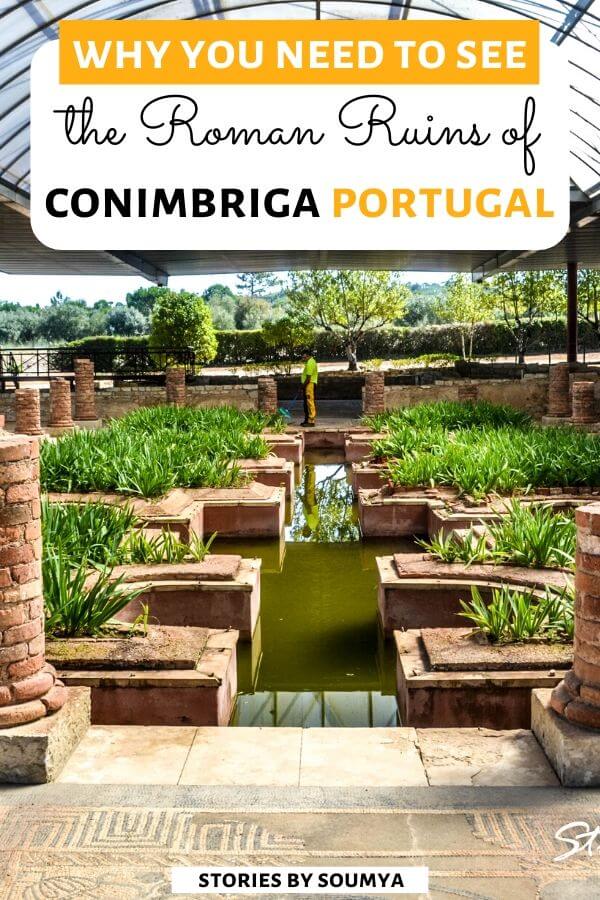
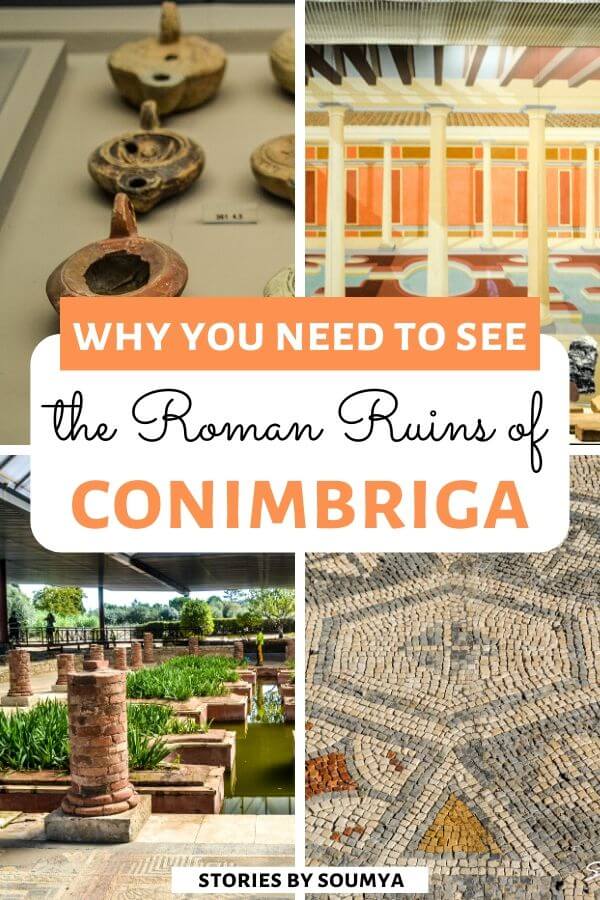

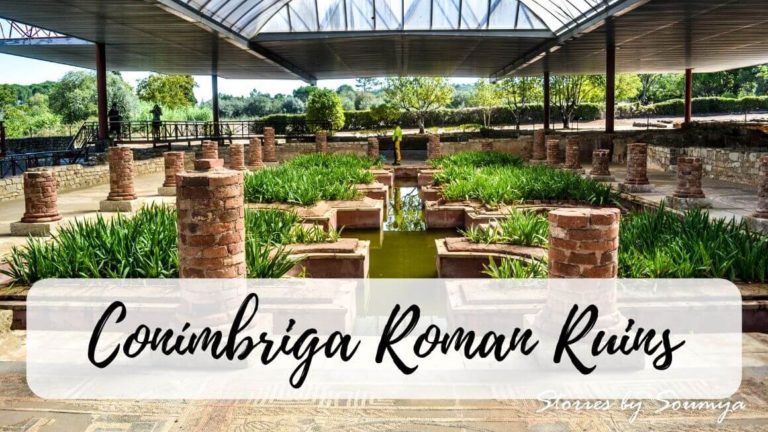
I always forget that the Romans were literally EVERYWHERE. There are certain stereotypical places we imagine Roman ruins existing, but upon deeper thought of course it makes sense that they’d be found in other countries like Portugal too. Very interesting site. When I hiked Hadrian’s Wall from Bowness-On-Solway to Newcastle I got to see a bunch of Roman Forts, towns, and milecastles, but none of them had such well-preserved mosaics like this. It always stuns me when delicate pieces survive thousands of years somehow, I can’t wrap my mind around the fact that actual people built these things and lived in them and touched them. At Vindolanda Roman Fort they had a hair net! Light as a feather and somehow still in tact! The jewelry and glass pieces always surprise me too, with paint still on them.
I can’t believe a hair net would survive that long. Now I really want to see that fort. It is strange how these things have lasted this long just to let us know of someone’s existence from centuries ago.
The collection of mosaic floors is spectacular! I always love seeing mosaics, but it is even more amazing when you think people were walking on these patterns over 1000 years ago. Conímbriga looks like a fantastic place to explore!
p.s. those wedge shaped bricks are genius!
Absolutely. That’s exactly what I thought when I saw those bricks. Super genius.
Wow I had no idea that these ruins existed! Thanks for sharing, sounds like an amazing trip!
I had actually never heard of this site; it looks really interesting and those mosaics are so intricate.
I’d never heard of Conimbriga ruins before in Portugal, thanks for sharing! Hoping to go to Portugal on my next trip and will definitely add this into our itinerary.